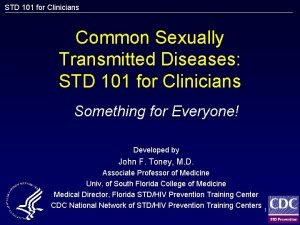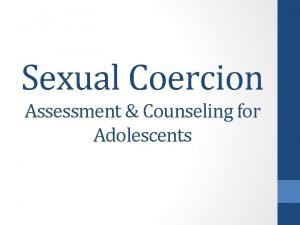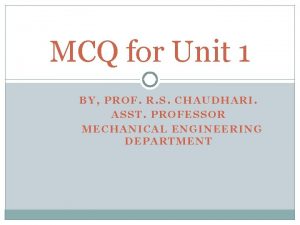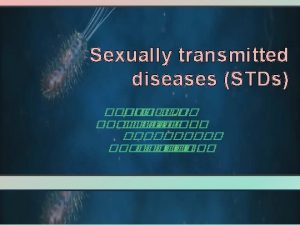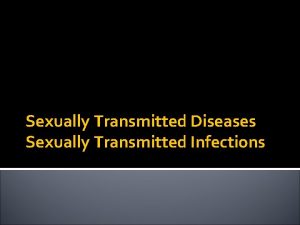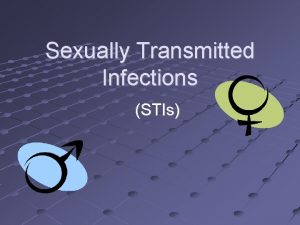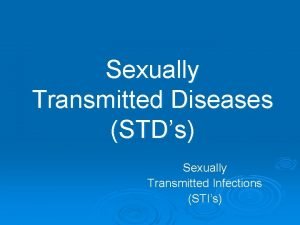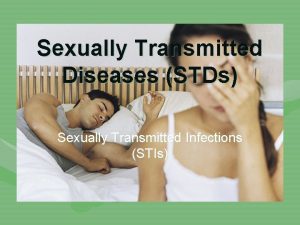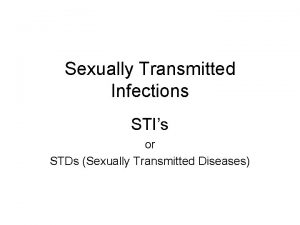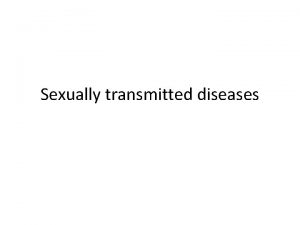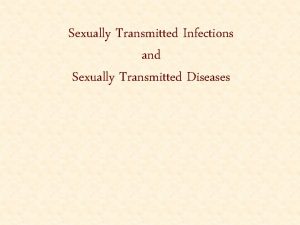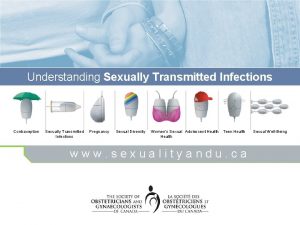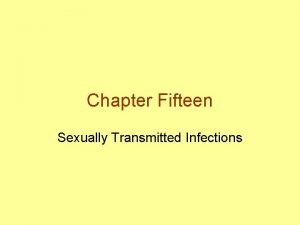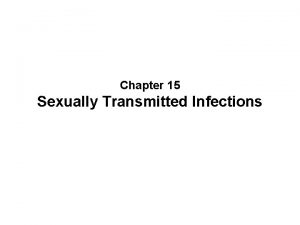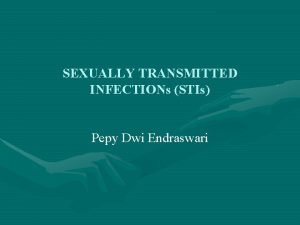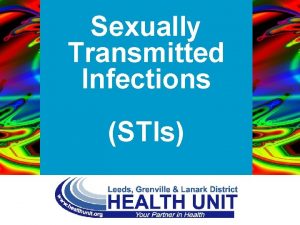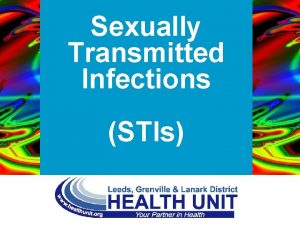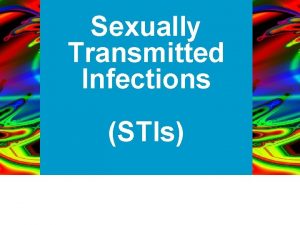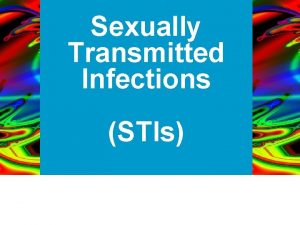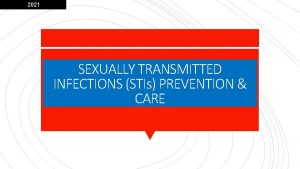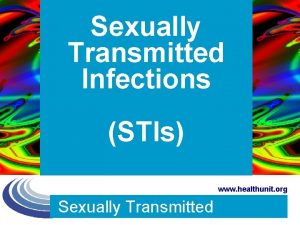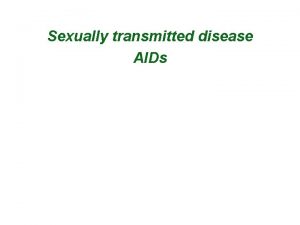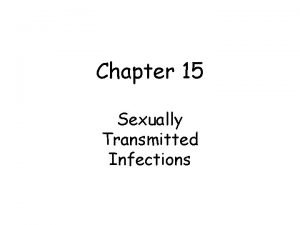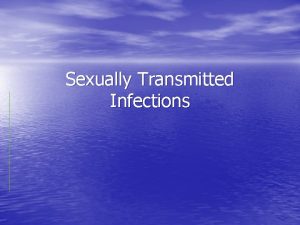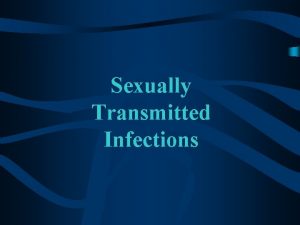Sexually transmitted infections or STIs are a term













































































- Slides: 77



Sexually transmitted infections or STIs are a term to describe over 25 different infections that can be transmitted through sexual activity, vaginal sex, oral sex, anal sex, or bodily fluids


• Anyone who is sexually active • Anyone who has sexual contact of any kind with an infected person • Many people do not know they are infected and spread the disease without knowing • Teenagers are at the highest risk for STIs and most often get infected with STIs


1. Unprotected Sex 2. Multiple Sex Partners 3. Being under 25 and/or having sex for the first time at an early age 4. Alcohol Use 5. Drug Use 6. Trading Sex for Money/Drugs 7. Living in a community with a high prevalence of STDs (BOSTON) 8. Serial Monogamy 9. Having an STD 10. Only Using Birth Control

BACTERIAL Chlamydia Gonorrhea Syphilis All bacterial STDs can be treated with antibiotics

VIRAL Herpes HIV/AIDS Genital Warts (HPV) There is no cure for viral STIs Medication can be given to treat only symptoms of these STIs

PROTOZOA Crabs (Pubic Lice) All STIs caused by protozoa can be treated and cured with antibiotics or medicated creams

BACTERIAL STIS

• Bacterial STI that affects both boys and girls • The MOST COMMON STI • Causes: Any type of unprotected sexual activity including vaginal sex, or anal sex

BOYS May have no symptoms Burning sensation while peeing Pain during sex Rectal pain or discharge Testicular pain Discharge from the penis GIRLS • • Only 30% of women who have Chlamydia have symptoms Burning sensation while peeing Pain during sex Stomach pain- nausea and vomiting Rectal pain or discharge Milky vaginal discharge May never be able to have children if it goes untreated



• Bacterial STI that affects both boys and girls • Very common • Causes: Any type of unprotected sexual activity including vaginal sex, or anal sex • Can even get gonorrhea infections in the eye • Gonorrhea is not transmitted through such casual contact as hugging, shaking hands, sharing food, using the same eating utensils, drinking from the same glass, sitting on public toilets, or touching door knobs.

BOYS May have no symptoms Burning or pain while peeing Peeing more frequently White, yellow, or green discharge from the penis Red or swollen opening of the penis Sore or swollen testicles Sore throat (ORAL GONORRHEA) GIRLS • • • May have no symptoms Vaginal itching White, yellow, or green vaginal discharge Burning or pain while peeing Peeing more frequently Pain during sex Fever Severe lower abdominal pain Sore throat (ORAL GONORRHEA)





• Bacterial STI that affects both boys and girls • Very easily spread • Causes: Direct contact with the sores, vaginal sex, oral sex, and anal sex. • Syphilis is not transmitted through such casual contact as hugging, shaking hands, sharing food, using the same eating utensils, drinking from the same glass, sitting on public toilets, or touching door knobs.

STAGE 1: Primary Syphilis • • Painless sores or ulcers in or on genitals or mouth If syphilis is not treated at this stage, it will move on to Stage 2




Stage 2: Secondary Syphilis • • • Non itchy skin rash Rash may contain the bacteria Without treatment, the disease will move on to Stage 3



Stage 3: Latent Syphilis May have no obvious symptoms but the infection remains in the body May cause irreversible damage to organs Can still spread the disease without knowing

Stage 4: Tertiary Syphilis Serious damage to the nervous system, heart, brain, or other organs, and death may result This stage can result in mental illness, blindness, deafness, memory loss, heart disease, and neurological issues



All bacterial STIs can be treated with antibiotics You and your partner should get treated at the same time

VIRAL STIS

Causes: Skin-to-skin contact Anal sex Vaginal sex Oral sex Kissing Transmission is possible even when no sores are present. There is no cure for herpes and once someone gets it, it stays with them forever.

HSV- 1 Usually on the mouth/lips “Cold Sore” or “Fever Blister” Can also occur on the genitals or eye Painful open red blisters Flu-like symptoms Disappears within 314 days HSV-2 Usually on the genitals but can occur on the lips Occurs 1 -2 weeks after exposure Tingling sensation in the affected area A group of small red bumps/blisters appear Painful/Itchy





There is no cure for Herpes. Antiviral medications can reduce the frequency of outbreaks and speed the healing of the outbreaks

Genital Warts are caused by the Human Papillomavirus (HPV) Can lead to cervical cancer in women Can be transmitted when warts are not present Causes: Sexual contact Vaginal sex Oral sex Anal sex Direct skin-to-skin contact with an infected individual.

Small gray/flesh colored swelling in the genital area Several cauliflower shaped warts on the genital area Itching or discomfort in the genital area Bleeding during sex




Vaccine: Gardasil Only protects you from certain strains of HPV Talk to your doctor about getting the vaccine Condoms: May not fully protect you from HPV because of the way it is transmitted but more effective than having unprotected sex

There is no cure for HPV Many HPV infections will resolve on their own without causing any long-term harm Some may cause long term complications such as cervical cancer in women so it is very important for girls to get annual PAP smears when they become sexually active HPV may require treatments to remove warts or abnormal cells

Virus that is present in: Blood Semen Vaginal secretions Breast milk Causes: Unprotected anal sex Unprotected vaginal sex Unprotected oral sex IV drug use From an infected mother to her newborn during childbirth or breast-feeding

HIV doesn't kill anybody directly. Instead, it weakens the body's ability to fight disease. Infections which are rarely seen in those with normal immune systems are deadly to those with HIV. Weakened immune system puts you at risk for many opportunistic infections Kaposi’s Sarcoma Yeast Infection Oral Ulcers



The only way to know whether you are infected is to be tested for HIV You can get tested at the doctor or find a testing site in your area

There is no cure or vaccine for HIV or AIDS. There are, however, a number of drugs and combinations of drugs that allow people with HIV or AIDS to stay healthy for longer periods of time.

PROTOZOAN STIS

Pubic lice are small, six-legged creatures that infect the pubic hair area and lay eggs. Causes: Sexual Activity Physical contact with contaminated objects such as toilet seats, sheets, and blankets. Some women have gotten pubic lice while trying on bathing suits at a store.

Eggs or actual lice may be seen in pubic hair Itching in the area that is covered with pubic hair Sores in the genital area due to bites and scratching


Risk factors include: Being sexually active Having multiple sexual partners Having sexual contact with an infected person Sharing bedding or clothing with an infected person

Avoid sexual or intimate contact with infected people or use safe sex practices Good personal hygiene Do not try on bathing suits without underwear

Special shampoo used to kill lice


At your table, create the world’s worst STI What type of STI is it? What are the symptoms? How is it transmitted? How is it diagnosed? What is the treatment/cure? What is the name of the STI? Who is most likely to get it? (age, sex, geographic location, etc. )

Abstinence: Only 100% guarantee that you will not become infected with an STI Not from just vaginal sex, but sexual activity in general in order to be 100% protected

If you do decide to become sexually active, ALWAYS PROTECT YOURSELF Condoms: Best way to prevent STIs if you are sexually active Greatly reduces the risk of getting a sexually transmitted disease (although not 100% effective) Must be used properly and 100% of the time in order to be effective Male condoms are most often used, but if you are allergic to latex, use a female condom or a latex free male condom

PROPER CONDOM USE


Try to limit the amount of people you have sex with and try to chose those who also have not had sex with many other people Communicate openly with your partner to see if they have been exposed to any STDI before or have had a history of IV drug use


Avoid alcohol and drugs Makes you more susceptible to make bad decisions that you would not normally make

Get tested as soon as you feel there is a problem Showing signs & symptoms of an STI Routinely if you are sexually active


You should get tested at the first sign of a problem in order to avoid serious complications Because many times STIs have no symptoms, you should talk to your doctor about getting screened when you go for your check up Girls: STI exams are not a normal part of a gynecological exam. Talk to your doctor about getting tested


When I think about STIs and HIV, I feel… My chances of keeping myself free of STIs and HIV are… I think some teens get infected with STIs because they… If I found out I had and STI or HIV, one person I could go to would be…

High Risk, Low Risk, No Risk Routes of Transmission Introduction to Relationships
 A bacterial std that usually affects mucous membranes
A bacterial std that usually affects mucous membranes Nursing management of reproductive tract infection
Nursing management of reproductive tract infection Chapter 24 lesson 1 sexually transmitted diseases
Chapter 24 lesson 1 sexually transmitted diseases Std
Std Chapter 24 sexually transmitted diseases and hiv/aids
Chapter 24 sexually transmitted diseases and hiv/aids Std
Std Mikael ferm
Mikael ferm Infections opportunistes digestives
Infections opportunistes digestives Opportunistic infections
Opportunistic infections Amber blumling
Amber blumling Storch infections
Storch infections Postpartum infections
Postpartum infections Methotrexate yeast infection
Methotrexate yeast infection Salmonella life cycle
Salmonella life cycle Storch infections
Storch infections Retroviruses and opportunistic infections
Retroviruses and opportunistic infections Opportunistic infections
Opportunistic infections Classification of acute gingival infections
Classification of acute gingival infections Bone and joint infections
Bone and joint infections Genital infections
Genital infections Understanding the mirai botnet
Understanding the mirai botnet Bacterial vaginosis
Bacterial vaginosis Class scyphozoa
Class scyphozoa Coercion
Coercion Dimorphism meaning
Dimorphism meaning Sexual harassment training quiz
Sexual harassment training quiz Nematoda
Nematoda Frustrated cargo meaning
Frustrated cargo meaning Protists habitat
Protists habitat Protista reproduction
Protista reproduction Illinois sex offender management board
Illinois sex offender management board Atis sexually or asexually
Atis sexually or asexually Spider phylum
Spider phylum Pinacoderm
Pinacoderm Male orgasm anatomy
Male orgasm anatomy Child abuse quiz
Child abuse quiz Cnidaria class
Cnidaria class Unokais
Unokais How do birds have sexually reproduce
How do birds have sexually reproduce Ophiurodea
Ophiurodea Do worms reproduce sexually or asexually
Do worms reproduce sexually or asexually Whale phylum
Whale phylum Flat pivot bearing
Flat pivot bearing Electronically transmitted postal ballot system
Electronically transmitted postal ballot system Transmitted light examination in questioned document
Transmitted light examination in questioned document A song transmitted orally which tells a story
A song transmitted orally which tells a story The totality of learned socially transmitted behavior
The totality of learned socially transmitted behavior Term to term rule
Term to term rule Quadratic sequence formula
Quadratic sequence formula Accounting for serial bonds
Accounting for serial bonds Short term planning and long term planning
Short term planning and long term planning Short term goals examples
Short term goals examples Short term human resources
Short term human resources Minterm and maxterm expansion
Minterm and maxterm expansion Term-to-term rule
Term-to-term rule Research paper on financial planning and forecasting
Research paper on financial planning and forecasting Position to term rule worksheet
Position to term rule worksheet Rules in finding the nth term
Rules in finding the nth term Long term memory vs short term memory
Long term memory vs short term memory Difference between long term and short term liabilities
Difference between long term and short term liabilities Firm risk scorecard
Firm risk scorecard Alfred adler was a neo-freudian who coined the term
Alfred adler was a neo-freudian who coined the term Higher terms
Higher terms Ventral anatomical position
Ventral anatomical position What part of the brain stores long term memory
What part of the brain stores long term memory The term infrastructure refers to
The term infrastructure refers to Short term memory
Short term memory Near-term availability
Near-term availability Enseignement scientifique
Enseignement scientifique Geometric sequence formula
Geometric sequence formula Gsa str
Gsa str Impressionism characteristics
Impressionism characteristics The term “bicameralism” refers to the
The term “bicameralism” refers to the Palpitation
Palpitation Wesel bayar termasuk utang jangka
Wesel bayar termasuk utang jangka Skipton girls high school term dates
Skipton girls high school term dates -in suffix medical term
-in suffix medical term Short term pricing strategies
Short term pricing strategies



